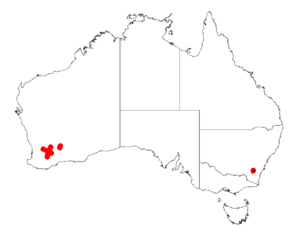Fibre-barked wattle facts for kids
Quick facts for kids Fibre-barked wattle |
|
|---|---|
| Conservation status | |
| Scientific classification | |
| Genus: |
Acacia
|
| Species: |
inophloia
|
 |
|
| Occurrence data from AVH | |
The Acacia inophloia, often called the fibre-barked wattle, is a cool tree or shrub. It belongs to the Acacia family, which is a large group of plants. This special wattle is found only in Western Australia.
What Does the Fibre-barked Wattle Look Like?
This plant can grow as a shrub or a small tree, usually reaching about 1 to 4 meters (3 to 13 feet) tall. It has unique, tough bark that feels like strong fibers. The bark on its main trunk is shaggy and stringy. On its outer branches, the bark peels off in thin curls, a bit like the "minni ritchi" style seen on some other wattles.
When new shoots appear, they are often sticky and a bright yellow-green color. The plant's "leaves" are actually called phyllodes. They are grayish-green, thin like threads, and gently curved. Each one can be 6 to 15 centimeters (2.4 to 5.9 inches) long.
Flowers and Seed Pods
The fibre-barked wattle blooms from August to October. During this time, it produces bright yellow flowers. These flowers grow in simple clusters, with one cluster appearing where each leaf meets the stem. The flower heads are shaped like small cylinders or oblongs, about 8 to 20 millimeters (0.3 to 0.8 inches) long and 4 to 6 millimeters (0.16 to 0.24 inches) wide. Each flower head is packed with 50 to 76 tiny flowers!
After the flowers fade, long, thin seed pods start to form. These pods can be up to 8 centimeters (3.1 inches) long and 2.5 to 4 millimeters (0.1 to 0.16 inches) wide. Inside, they hold shiny, mottled brown seeds. The seeds are usually oval or oblong and about 2.3 to 5 millimeters (0.09 to 0.2 inches) long.
Where Does the Fibre-barked Wattle Grow?
This wattle is endemic to Western Australia. This means it naturally grows only in this specific area and nowhere else in the world. You can find it in parts of the Wheatbelt and Goldfields regions.
It prefers to grow in different types of soil, including gravelly, sandy, and loamy soils that come from granite rocks. Most of these plants are found between the towns of Quairading and Kulin. They are often part of shrubland communities, which are areas where many different types of shrubs grow together.


